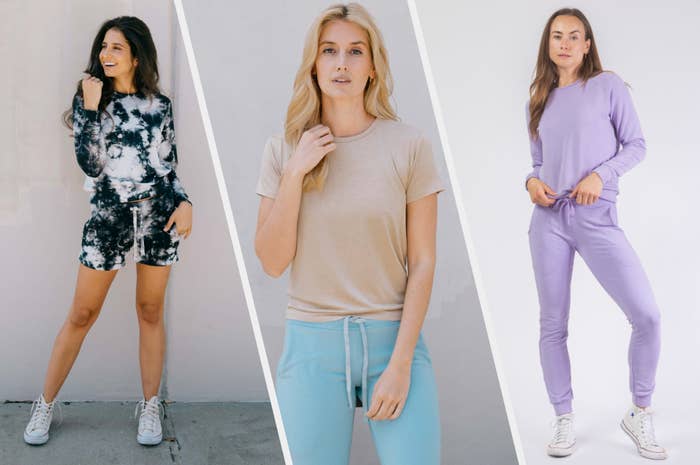How Fabric Choices in Branded Clothing Affect Comfort and Style
How Fabric Choices in Branded Clothing Affect Comfort and Style
Blog Article
The Relevance of Lasting Garments: How It Affects the Environment and Your Closet
Lasting clothing is significantly acknowledged for its crucial function in lessening the ecological impact of the quick apparel industry. By concentrating on green products and ethical production approaches, it attends to pressing eco-friendly concerns. This shift not just benefits the earth yet also influences consumer options, causing a more thoughtful technique to closet monitoring. Comprehending these characteristics increases necessary inquiries regarding fashion's future and personal obligation in shaping it.
The Environmental Impact of Fast Style

Advantages of Sustainable Materials
Sustainable materials offer substantial benefits, specifically via green fabric options that lessen environmental harm. These products also show durability and longevity, decreasing the demand for regular replacements. Therefore, they add to an extra sustainable fashion business and promote accountable customer behavior.
Eco-Friendly Material Choices
While the fashion business has actually long been connected with quick patterns and ecological damage, the increase of eco-friendly textile choices provides a transformative chance. Lasting materials such as organic cotton, hemp, and Tencel have gotten popularity as a result of their lower eco-friendly effect. These fabrics are frequently generated without harmful pesticides and call for less water, reducing their carbon impact - Branded Clothing. Additionally, several eco-friendly textiles are eco-friendly, adding to a circular economic situation by decreasing waste. Selecting sustainable products not just supports ecologically accountable techniques but also advertises healthier ecological communities. As consumers end up being more conscious of their acquiring power, the need for environment-friendly fabrics motivates brand names to introduce and adopt even more sustainable production methods, eventually profiting the planet and future generations
Sturdiness and Long Life Benefits
Lots of customers are progressively identifying the durability and longevity benefits of sustainable materials in their clothes options. Unlike standard textiles, sustainable products such as natural cotton, hemp, and recycled polyester are engineered to withstand deterioration, causing garments that last longer. This lowered regularity of replacement not just conserves customers cash with time however additionally diminishes waste generated by rapid style. Additionally, lasting clothing frequently employs eco-friendly manufacturing approaches that boost textile toughness, adding to a decrease in the overall carbon footprint. By spending in sturdy apparel, customers can grow a much more lasting wardrobe while appreciating top quality pieces that keep their visual and capability in time. Consequently, sturdiness and durability stand as key advantages of picking lasting products.
Lowering Waste Via Sustainable Practices
Reducing waste in the garment industry can be achieved via cutting-edge practices such as upcycling and repurposing products. Additionally, adopting minimal wardrobe techniques motivates consumers to prioritize high quality over amount, inevitably reducing clothing usage. With each other, these strategies contribute substantially to a much more lasting clothes model.
Upcycling and Repurposing Materials
Upcycling and repurposing materials have actually become ingenious strategies in the fashion business, changing thrown out textiles right into useful brand-new products. This strategy not only lessens waste however additionally encourages creative thinking and individuality in garments design. By taking old garments and materials, designers can develop special items that show personal design while decreasing the need for brand-new sources. Additionally, upcycling typically requires much less power and water contrasted to conventional manufacturing procedures, significantly reducing the ecological impact of fashion. As customers come to be a lot more aware of sustainability, the popularity of upcycled apparel remains to rise, promoting a round economic climate. Inevitably, these practices contribute to a much more lasting future, where style prioritizes environmental wellness over rapid manufacturing and intake.

Minimal Closet Strategies
As individuals progressively seek to lessen their ecological effect, embracing minimalist closet methods has actually gotten traction as an efficient technique to lasting style. These methods highlight high quality over quantity, encouraging consumers to curate a smaller collection of versatile, long lasting garments. By concentrating on ageless pieces that can be combined and matched, people can reduce the informative post regularity of acquisitions and inevitably reduce waste.Additionally, minimalism promotes mindful consumption, prompting customers to review the honest and environmental implications of their choices. This approach not just promotes a more sustainable way of living however additionally simplifies daily decision-making regarding attire. As individuals accept minimal concepts, they contribute to a style culture that values sustainability and responsible consumerism, inevitably bring about an extra eco-conscious society.
The Duty of Ethical Labor in Sustainable Fashion
While numerous customers are increasingly conscious of the ecological consequences of their apparel selections, the importance of moral labor techniques in lasting style can not be forgotten. Moral labor includes fair earnings, safe working problems, and regard for workers' civil liberties, developing the foundation of responsible fashion manufacturing. Brands that focus on ethical labor not only boost areas but additionally set a standard for liability in the industry.Moreover, the integration of honest techniques fosters openness, making it possible for consumers to make enlightened choices about their acquisitions. This technique contrasts dramatically with quick style's exploitative labor versions, which usually prioritize revenue over individuals. By supporting business devoted to ethical labor, consumers add to a system that values human dignity alongside ecological sustainability. Honest labor is not simply an add-on; it is crucial to the wider mission of sustainable fashion, ensuring that the quest for eco-friendliness does not come at the expense of human rights.
The Influence of Lasting Garments on Carbon Emissions
Lasting clothes has the potential to significantly decrease carbon exhausts connected with the style market. Typical garment production adds especially to greenhouse gas exhausts, largely as a result of energy-intensive manufacturing procedures and making use of non-renewable sources. In contrast, lasting style concentrates on environmentally friendly materials, such as organic cotton or recycled fibers, which commonly need less power to produce.Moreover, sustainable brand names often tend to adopt more reliable manufacturing practices, decreasing waste and reducing overall exhausts. By prioritizing resilience and classic layout, sustainable clothes encourages consumers to get less often, additional minimizing the carbon impact connected with overconsumption.Additionally, several sustainable brand names are committed to openness in their supply chains, enabling customers to make informed choices that align with their values. Ultimately, shifting towards lasting clothing can cause a significant decrease in carbon emissions, adding to a much healthier world and an extra sustainable future for the fashion sector.
Supporting Local Economic Situations With Sustainable Options
The change toward sustainable apparel not only addresses environmental worries yet also significantly advantages neighborhood economic climates. By choosing sustainable style, customers typically sustain regional craftsmens and little organizations, improving neighborhood resilience. These business commonly run on a smaller sized scale, focusing on workmanship and moral practices over mass production.Investing in locally made sustainable clothing fosters job creation and stimulates economic growth within areas. As customers come to be more aware of the ecological influence of their acquisitions, they significantly seek products that reflect their worths. This need urges local manufacturers to take on lasting techniques, contributing to a round economy.Moreover, sustaining regional services lowers transport discharges, straightening with eco-conscious customer actions. The interconnectedness of lasting garments helpful resources and neighborhood economic situations highlights the vital duty that individual choices play in promoting both financial and environmental health. By cultivating these regional connections, areas can prosper while also functioning in the direction of a more lasting future.
Changing Your Closet: Tips for a Lasting Wardrobe
As individuals look for to decrease their environmental influence, transforming a storage room right into a sustainable closet ends up being an essential action. One efficient strategy is to review existing garments, keeping only items that are worn frequently which line up with sustainability objectives. Prioritizing top quality over quantity is important; buying long lasting pieces from environmentally friendly brand names can substantially minimize waste.Additionally, including used items can revive a wardrobe while minimizing environmental damages. Organizing garments swaps with pals or giving away unused products can better promote sustainability.When buying, people must look for materials that are organic, recycled, or eco-friendly, and stay clear of fast fashion stores - Branded Clothing. Lastly, exercising mindful consumption by attentively considering each purchase can add to a more lasting way of living. By executing these pointers, one can develop a wardrobe that mirrors individual style while sustaining ecological stewardship
Regularly Asked Inquiries
How Can I Identify Sustainable Clothing Brands?
To identify sustainable clothing brands, one need to look into products made use of, examine for certifications like Fair Trade, and examine the brand's transparency concerning their manufacturing procedures, labor techniques, and ecological effect, making certain environment-friendly and honest methods are focused on.
What Are the Expenses Related To Lasting Fashion?
The costs connected with sustainable fashion can vary considerably. Greater manufacturing expenditures, moral sourcing, and environmentally friendly products usually bring about enhanced list prices, which might deter some consumers while attracting environmentally mindful customers.
Can Sustainable Clothes Be Stylish and fashionable?
Lasting clothing can without a doubt be stylish and fashionable. Developers significantly prioritize cutting-edge products and moral manufacturing approaches, showing that style and sustainability can exist together. Consumers currently have varied alternatives home that blend visual appeals with ecological awareness.
Exactly How Does Laundering Clothing Affect Their Sustainability?
Cleaning garments considerably influences sustainability by consuming water and energy, adding to pollution, and creating microplastic launch. Constant cleaning can deteriorate textiles, shortening their lifespan and enhancing the demand for substitutes, eventually worsening ecological worries.
What Is the Lifespan of Sustainable Clothes Contrasted to Rapid Fashion?
The life expectancy of sustainable apparel commonly goes beyond that of rapid style things, frequently enduring numerous years as a result of quality materials and workmanship. In comparison, fast style garments might break down swiftly, demanding more constant substitutes. Sustainable apparel is increasingly recognized for its important function in reducing the ecological impact of the rapid style sector. While lots of consumers are progressively aware of the environmental repercussions of their garments choices, the value of honest labor techniques in sustainable fashion can not be ignored. Branded Clothing. Sustainable garments has the prospective to substantially reduce carbon emissions connected with the style sector. In contrast, sustainable fashion focuses on green products, such as organic cotton or recycled fibers, which often need much less energy to produce.Moreover, sustainable brands have a tendency to take on more efficient manufacturing techniques, reducing waste and lowering general emissions. By prioritizing resilience and ageless layout, lasting clothes encourages consumers to acquire much less often, more lowering the carbon footprint associated with overconsumption.Additionally, numerous sustainable brand names are dedicated to openness in their supply chains, making it possible for consumers to make enlightened selections that straighten with their worths
Report this page